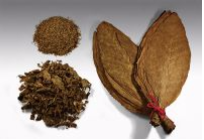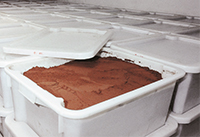

The contents of our website are intended exclusively for adults over the age of 18.
Please confirm that you are of legal age.
I am at least 18 years old
Confirm
The contents of our website are intended exclusively for adults over the age of 18.
Please confirm that you are of legal age.
I am at least 18 years old
ConfirmThe classic Bavarian Schmalzler made by Pöschl is dark in colour, medium-fine grained and relatively moist. The name Schmalzler comes from the fact that this snuff used to be refined with clarified butter (Butterschmalz in German).
back to products
Raw tobacco
In this type of snuff, dark tobaccos are processed, such as they are used in the production of cigars. These are dark – air-cured tobaccos.
One special type of Schmalzler snuff is Mangotes, which is also known as Fresko. This spiced tobacco is produced in Brazil, which is why this Schmalzler is often referred to by the name “Brasil”. Mangotes gets its rum-type flavour through fermentation in its country of origin. It is sent to Germany in traditional packaging after being spun into strands and sewn into untanned cow skins.



The raw tobaccos are initially crushed in a mill before being mixed with a fermenting sauce. The production of the fermenting sauce is carried out according to recipes which are hundreds of years old. Ingredients are water, sugar in the form of syrup and molasses and fruit extracts. After these have been mixed together, a good fermentation develops.
Fermentation
The secret par excellence of the production of Brazilian snuff is the repeated fermentation of the raw tobacco. The material is strongly moistened with a sauce which is fermented on an alcohol basis, mixed thoroughly, packed into crates and fermented for several months. Over this period the characteristic Brasil or Schmalzler snuff taste develops, which is much more intensive in the tobacco stems than in the raw tobacco granulate. The crucial aspect for successful fermentation is that the fermentation sauce continues to ferment properly on the tobacco. An indication of a good fermentation process is the fact that the granulated tobacco material does not dry (identifiable by the smell and the surface of the crates).
Drying and mixture composition
After the fermentation period, the crates are emptied, the contents cooled and partial quantities dried in each case. This is carried out on a drying plate made of stainless steel. Residues remain moist. After this subdivision into dry, semi-moist and moist material, the combining of the mixtures in accordance with decades-old recipes begins for the corresponding Schmalzler types, with it being left to the tobacco blender to decide the consistency of the mixture which he or she puts together.
When the mixture is being composed, Mangotes or Fresko is also added in accordance with a recipe. The tobacco rods are previously cut into thin slices. Mangotes regulates the intensity of the pinch of tobacco, mainly in natural Schmalzlers.
Grinding or “rubbing tobacco”
Tobacco is reduced to a fine tobacco flour on devices known as “rubbing chairs” in German, which were specifically designed for the snuff industry in previous centuries. This is why the expression “rubbing” and not “grinding” is used. These devices were initially driven by oversized transmissions using hydropower, then with diesel, and later – and still today – with electric motors. The tobacco is rubbed with a grinder made of softwood, which rotates vertically around the grindstone, with the mixture being located in a trough on the grindstone. Grinding is a slow method which is extremely gentle on the material. Due to the slight warming during the rubbing process, the moisture evaporates, so that after the rubbing process is finished and subsequent sifting, the tobacco flour produced is dust dry. After being filled into boxes it is allowed to cool down for several days before the final blend is produced.

Final mixing
The dry tobacco flour produced after rubbing is referred to as “ungreased” tobacco flour. This expression comes from the fact that until around 1930, Schmalzler was still sold dry. In order that it can be sniffed, the tobacco flour has to be greased. Until 1930, animal or vegetable fats were used, including lard (German = Schmalz). This is why this type of snuff is also called “Schmalzler”. Due to its shelf-life, it could only be mixed with very small quantities of fats and oils. From 1930 on it was decided to replace the conventional fats with liquid paraffin/white oil, so that it was possible to produce large quantities of the end product. Pöschl was the pioneer in this. Up to this time it was mainly natural snuff which was used, i.e. tobacco flour greased with lard (“Schmalz”) or paraffin oil. But then the flavoured Schmalzler snuffs were added, with Pöschl again taking on the pioneering role. After the end of the war it was then the flavoured types of Schmalzler which became increasingly popular in terms of quantities, with Schmalzler with natural aromas becoming popular specialities.
When white oil is added and flavours metered in, the work is carried out exactly according to precise recipes, some of which are already more than 100 years old. Production is carried out completely separately from menthol snuff production, partly due to the diversity of the ingredients used. The finished types of Schmalzler are filled into small plastic boxes and kept in a separate room for filling.
Final packaging
In contrast to the wide variety of tins and boxes used for menthol snuff, Bavarian Schmalzler is still packed in the traditional manner in bags containing 100 g. In addition, there is a modern type of packaging with foil sachets, whose contents are 25 g, which are produced from rolls. The 100 g bags are packed in cartons of 5, the sachets in retail cartons of 10. In the past the bags were packed completely by hand. Today this is carried out in a semi-automatic machine. Packing in sachets is carried out on modern plant.

